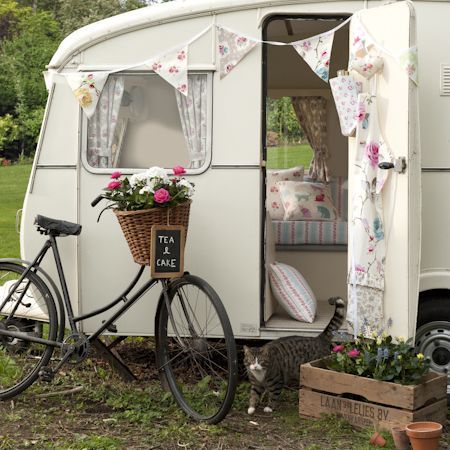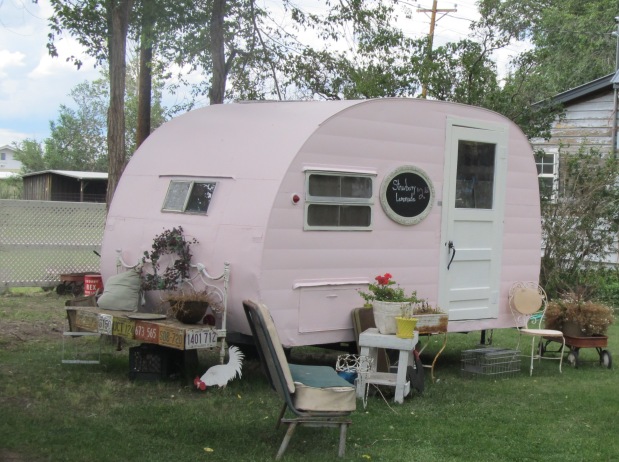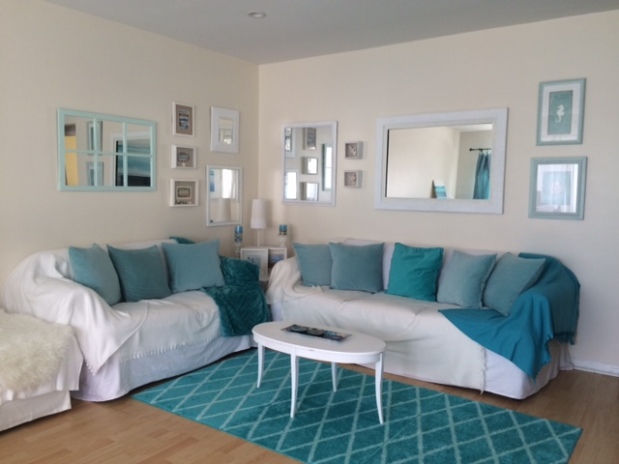When summer arrives, I invariably think of hitting the road for a camping trip to one of the many great campgrounds situated along California’s Pacific Coast Highway or a State Park.

This vintage pink and white trailer named “Audree” has been revamped for the ultra-feminine, glamour-camper, or “glamper.”
While I enjoy the experience of the great outdoors and pitching my own tent—especially the type with a netted peek-a-boo roof that allows you to sleep under the stars without the accompanying mosquito bites—I have recently started fantasizing about hitting the campground in high style—in a glamorous camper, or glamper.
Glamping, as it is called by trend-spotters, has apparently become a thing in both the US and Europe.

A German “glamper” created this cocoon of shabby chic coziness for her family’s trips around Europe.
The glamping movement involves designer-camping enthusiasts, mostly women, buying up vintage motor homes and camper-trailers, and renovating or redecorating them in a variety of design styles. They even name their upscale campers—kind of like sailors name their ships—with monikers like “Marilyn” or “Jeannie.”
A recent search on the Internet, particularly Pinterest, using the search term “glamper,” proffered up a plethora of photos.

I would love to park this shabby chic camper in my backyard as a private retreat where I could read or host afternoon teas.
I found images of vintage motor homes and caravans with interiors that had been done up in shabby chic, French country, coastal chic, junk gypsy, mid-century modern, and more.
While many of these designer-cum-campers join “Glamping Clubs” and meet up with like-minded Glampers at luxury campgrounds, others forego the actual camping trip, and just park these little caravan cuties in their driveway as a “spare room” to use as a personal retreat or for kids’ summer sleep-overs.
I love this idea! The camper-as-spare-room idea would only work for those with a flat driveway, of course.

It’s hard to believe this French Country sitting area is inside a camper! I’d feel right at home here. Visit this European designer’s blog to see her amazing “before” and “after” renovation photos.
(My driveway is on a steep hill, so this option won’t work for me. I have visions of my teen daughter and her pals rolling away in the night as they slumber.)
Let’s get back to camping.
What could be better than fusing my love of the outdoors with my love of design, and all things shabby chic, by creating a romantic shabby chic camper?
My girlie-girl camper would be my own little of cocoon of coziness.
I think I’m favoring a motor-home or RV as one drivable unit, rather than a trailer I’d have to pull behind a truck.
I’m already imagining how I’d white-wash all the faux-wood paneling inside a 1970s motor home.
I’d add paint trim and other accents in shades of turquoise, aqua and cerulean for a “shabby beach” look.

This sweet sleeping nook is in a camper called “Pollyanna.” See more pictures and read more about it at this American designer’s blog.
It would be great to come in from a day of fun in the sun at a coastal campground, grab a cold drink from the camper fridge, and plunk down on my cozy camper couch decorated with easy-wear white denim slipcovers and soft toss pillows.
I also wouldn’t mind curling up in my flouncy, floral sleeping nook with a good book.
The indoor toilet wouldn’t be such a bad thing, either.
Late-night card games around the pull-out table after kayaking on a mountain lake?
Sleeping under a fluffy duvet after a full day of hiking in the forest?
Peering at the great outdoors through sun-washed linen drapes as the sun comes up?
Check, check, and check!
Hello summer…and here’s to dreaming about a cozy cottage on wheels. Happy camping to all!
To read a more comprehensive description of glamping (accompanied by some great photos of both vintage caravans and modern camper-trailers that have been fully renovated), visit designer Joni Webb’s “Cote de Texas” blog. She nailed it!
You’ll find even more camper photos at Cozy Little House, where they’ve documented a range of vintage glampers, from those redone in black and white stripes to one that looks like a 1950s diner.
More great “glamping” coverage can be found at AnyoneCanDecorate.blogspot.com, including the trend of glamping in fancy tents.












